One of the “advantages” of being in the same office suite as me is hearing (a) that arborist wood chips are about as close to a miracle product as you can get and (b) that landscape fabric is hell on (the) earth. So my office mate Liz, either because she was convinced of the above or just wanted to shut me up, decided to rip out the landscape fabric in her ornamental bed and replace it with wood chips. She even made it a family project, somehow convincing her two young daughters that this was “fun.” Here’s her pictorial essay of the process.
Before the switch
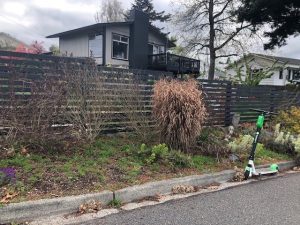
Why on earth does anyone still believe that “weed block” fabric actually does anything remotely related to controlling weeds? It provides a great substrate for all those weed seeds blowing around, which find themselves the recipients of any rainfall or irrigation. They germinate and grow like crazy – because they are WEEDS. It’s what they do.
Worse yet for the soil – all of those pores in the fabric that supposedly allow water and oxygen to move through are soon filled with bits of soil. The resulting mat is anything but permeable. But weeds love it!
The process
First Liz had to score some woodchips, which as you can see pretty much filled her driveway. The girls, however, thought they were a great addition.
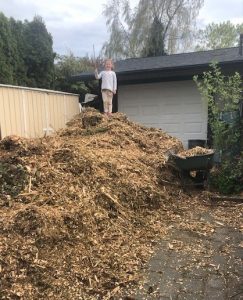
Next, all of that fabric had to come out. This is not an easy process, because the surface of the fabric was completely colonized by weeds. A mattock is a great tool for getting this done.

Now, let’s look at the soil underneath the fabric. You can see how dry it is. That’s because even during our rainy springs in the Pacific Northwest all of the rainfall stays on top of the fabric, allowing lush weed growth. The roots of all of the landscape plants get virtually none of this, and in the summer that’s a source of chronic drought stress.
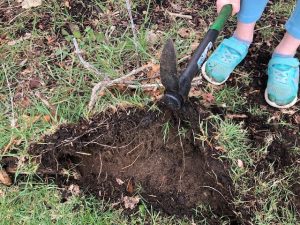
Fortunately, the soil underneath, while dry, looks pretty good. Once the shrubs and perennials are able to take advantage of the increased water and oxygen they will thrive.
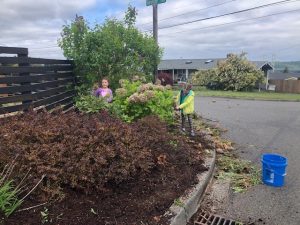
The results
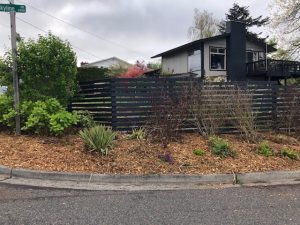
Maybe you don’t like the look of arborist wood chips, but it’s certainly better than the weedy mess that used to be there. Plus, the soil benefits from the increased water and oxygen, the beneficial microbes in the wood chips, and the slow feed of nutrients as those chips slowly decompose.
If you are ready to switch from “fabric fail” to “wood-chip win,” you can start with this fact sheet which will guide you through the process.
What an excellent way to teach the next (and current) generations about maintaining healthy soil!
nice looking end of the project, and great that the kids were involved in the work and that Mom got to play photographer ::)) we live in a much dryer climate, but are still mulching as much as we can – fortunately we can get free mulch from the local land fill transfer station.
Our wood chip pile became habitat for tonnes of giant rhinoceros beetle grubs. So we’re helping reverse Insectageddon, enriching our property (more cool bugs to look at), feeding the birds, and have something fun to do as we raise a few of the grubs in a little aquarium to see if more than one species of beetle emerges.
Lesser known perk of arborist wood chips
When the heavy rains come, will they get washed away, as it’s all on a slight slope?
Once these chips are moist, the roots and fungal hyphae grow into it. It does not wash away like bark mulch does.
While I love wood chips, so do southern weeds. In my climate they don’t significantly reduce weeding plus they add many hours of hard each spring labor hauling and spreading the 8″ deep layer needed to last through the year.
The rich soil and happy worms underneath are worth the effort but for weed prevention they get a D-.
If you scalp them and then put on a thick layer, the lack of light will kill them.
However, if your weeds are spreading underground from adjacent areas, there is no mulch – at all – that will prevent that. The rhizomes have a constant supply of resources from untouched plants.
Questions from a grumpy ol’ retired nurseryman. You are being quoted as the “end-all” expert on freshly chipped mulch being immediately used on an ornamental landscape. I’ve read your myth page. First, I’m in Memphis. Our soils here are heavy clay. Our rootzones average 2.5 times the canopy width. There are no deep-rooted plants. So your 4′ wide plant has a 10′ wide root zone covered in mulch.
Here are my concerns: You say there is a nitrogen deficient zone where chipped mulch touches the soil, albeit thin. This is a concern for annuals, perennials, shallow rooted shrubs like azaleas in our soil. The bulk and bag mulch preferred here is hardwood. It is shredded or hammered, which prevents wash in most cases, and it’s aged. If it’s used prematurely, annual foliage turns silver. Sawdust isn’t used here anymore, but in the 1970’s it was and did the same thing to annuals if the sawdust was still green. When the city started grinding up Christmas trees, they soon issued a statement recommending letting it age for 6 months because of the adverse effects.
Insects – we have crape myrtle bark scale here and crapes in every blasted yard! Elm bark beetles and Dutch elm disease. An inordinate amount of monster poison ivy vines.
When I look at the picture of the young girl, the problem appears to be the gardener, not the fabric. Only 2″ of coarse mulch should be on top the fabric. No (what appears to be) soil in top and no weeds allowed to encroach. Fabric is more for non-gardeners but maintenance is still required. If the person above gives the same amount of care now as before, her end results will be identical.
We have arborists, tree trimmers and tree butchers here. They all have to pay the mulch yard to dump and pay again to buy it as mulch or soil mixes. This looks like an attempt to save them some money. Sorry, but it does. On established, tough shrubs and trees, it may have no obvious adverse effect on their health.
One thing I always ask myself is “Does this happen in nature? Am I duplicating an already successful process? ” Just can’t see it! Thanks so much for your time.
When I say a shallow zone of N deficiency, I mean SHALLOW. Like 5 mm. That’s not where shrub roots are, and the only things that might possibly be affected are seedlings. It’s not going to affect transplants of any sort. The bulk of their roots are below 5mm.
Sawdust is a finely textured material. It causes problems for water and gas movement between the soil and the atmosphere. This doesn’t happen with coarse woody mulch.
There are no demonstrated adverse effects from using fresh chips. In fact, Dr. Jim Downer has shown that the first month of decomposition of chips releases a burst of nutrients that benefit soils and plants.
I can assure you that a woody debris layer is more natural than sheet mulching of any sort. The deep duff layer in any forest is what we should try to mimic in our landscapes.
Virginia Piedmont. Two areas in my garden, where wood chips are forbidden: the peony bed and the iris rhizome area. Otherwise it’s an annual application of 4″ all around. This year I nailed 40 cubic feet of fresh cedar! After 12 years the microbes have rendered the gray clay more orange, no anaerobic odor.
After a serious attack of artillery fungus (Sphaerobolus stellatus and Sphaerobolus iowensis) on my light gray house siding, I replaced the hardwood mulch border around the house foundation with pea gravel atop screening/porous landscape fabric/burlap repairs. It does require weeding but at least there are no more black tar dots on my house.
A bit off topic, as it relates to your previous posts on sheet mulching…
I was about to try sheet mulching – given that all Internet search seem to point in that direction for an organic way to kill grass and weed – but then I came across your blog and suggestions which are scientifically supported. This completely changed my strategy! Thanks.
I have a few questions as I will not be able to apply the method integrally (1 foot mulch), given that I have some established ground Juniperus (not quite the Horizontalus – but I don’t think they will get much higher than 1-3 feet), which I want to keep.
I was thinking of removing 2 inches of soil (i.e removing the sod to get additional clearance below the Juniperus), then adding 1 inch of compost and 9 inches of mulch (arborist wood chip) (total height above ground 8 inches) – and doing a donut around the Juniperus. If I chose not to remove the sod – I would likely only be able to apply 7 inches of mulch – would that be sufficient? Or in my situation, is it best to increase the clearance below the Juniperus (while disturbing the soil)?
Final question – is this strategy only valid for landscaping or can it be applied to a vegetable garden?
I apologize for all the questions – I want to get it right this time! Thank you.
Your questions are just fine here!
I suggest you retain the sod – just scalp it. There’s lots of good organic material there, plus fine roots from your plants.
Instead of 12″ of mulch, lay down 6″, then apply more as it settles. You want to maintain at least 4″ there to keep the light away from the underlying weeds.
You don’t need the compost if you keep the sod – saves you a bit of time and effort.
Although there is little to no research on vegetable gardens, there is no theoretical reason it would not work. However, you will want to avoid applying it around new seedlings. Established vegetables will be fine.
Thank you for your response – this will make process much easier.
The chips will be set on cascading 10 feet wide landings – where the landings are horizontal without slope. I assume arborist wood chips will provide good protection against water run-off, once stabilized by fungi growth, given as water can permeate through…Would I be correct? Would it be similar level to grass?
Much appreciated.
It might even be better than grass. Turf can be notoriously compacted, restricting easy water infiltration. It is impossible to compact coarse, chunky wood chips.
Mike, my experience with wood chips in the vegetable garden have convinced me to use straw and groundcover crops instead. The chips get in the way when planting seeds or seedlings. Straw can be raked away and then placed back again.
Chips can also be raked away and placed back again. Or placed elsewhere. Without more detail about your experience with wood chips it’s hard to see what your problem is.
I live on the east side of Washington state. Were can I find Arborist chips?
Try calling tree services, or chipdrop.com online.
Linda, the link to your fact sheet does not work on this page. Can you get someone to fix it? http://gardenprofessors.com/keep-the-fabrics-in-your-closet-and-off-of-your-soil/
WSU extension administration changed all the web addresses for their publications and now forces individuals to create personal acconts to download fact sheets. Rather than force people to share personal information in exchange for “free” information I have instead housed my publications on ResearchGate. I have changed the link to reroute readers to that site.
Hi Linda, I have read your blog and decided to have a go on using arborist wood chips on my out-of-shape lawn. some neighbors came and look at the wood pile claiming They are bad ( contain gum tree wood chips, leaves,and palm ). and some said it May attract carpenter ants and termite?? I do see Black ants running on the chips but in saying that They might be exis in my garden long ago.I found Australian are not very keen on using free wood mulch and I never see anyone using it. But to me it is a shame to see These organic material treated as valueless waste..what’ your thought about it?Thanks.
Your neighbors are incorrect, fortunately. Wood chips of any species are great as a mulch. Take a look at this peer-reviewed fact sheet on using wood chip mulches and let me know if you have other questions. https://www.researchgate.net/publication/315662938_Using_arborist_wood_chips_as_a_landscape_mulch_WSU_Extension_Fact_Sheet_FS160E?_sg=eLtDwEwpFfS9a_rF45Cl4AkeZGnMuuDjb5osznbt2tCqCFfMsGpMMmCDFIlXFtIww0PzxrxW3SYyIsyM3_yOZF-kS5ii729pTRGKJ1lK.9gTRGWJHJskEhbcioPC_DZrXt05v9bYHYiqO5JwhV_o3WxAjLkZ5UzhhZmpNo-KNNyb9m4MTziyGgqZCA1psng